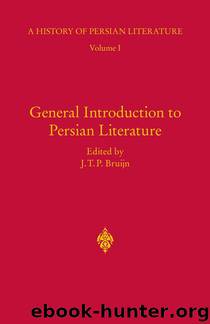A History of Persian Literature: I by Unknown

Author:Unknown
Language: eng
Format: epub
Published: 2019-11-14T16:00:00+00:00
10. Conclusion
In the preceding sections I have not attempted to classify systematically the “genres of court literature,” but rather to suggest that a wide variety of interrelated types of writing enjoyed the particular attention, and/or served the interests, of the courtly milieu. Within these broad categories it might be possible to identify sub-categories with more clearly defined generic characteristics (for example, the panegyric ghazal ), but this is a task best left to the authors of more specialized chapters in these volumes.
It is clear that, with the growth of an extensive literary tradition in Persian, writers increasingly looked back upon past works, to draw from them, comment upon them, or reinterpret them. Take, for example, Nezâmi of Ganje’s re-interpretation of—or a response to—Fakhr-al-Din of Gorgan’s Vis o Râmin in his Khosrow o Shirin or his critique, in the Haft Peykar, of what he perceives as the heroic ethos of Ferdowsi’s Shahname.76 As a natural consequence of this development, writing becomes increasingly “literary”—allusive, learned, drawing attention to its own sophisticated rhetoric, with a blurring of the distinctions between the languages of poetry and of prose, and an increasing approximation of the two.77 This is seen clearly in the works on style mentioned above (Section 8), which were intended for the poets and prose writers of the court, and whose authors were concerned both with stylistic eloquence in general and with the features and decorum appropriate to poetic and prose discourse. The approximation between the two is seen in the use of terminology: the opening section of the poem or epistle is discussed under the rubric “exordium” (tashbib); both poems and epistles consist of opening, transitional, and closing portions (matla’, makhlas, maqta’); the same generic categories apply to both, for example, madh ‘encomium’ in the qaside becomes tahmid ‘praise’ [of the recipient] in the epistle; they distinguish between “serious” and “non-serious” registers, and the style appropriate to, or characteristic of, various types of writing. The traditional privileging of poetry and its separation from prose are called into question by the attention given to prose style by the poets themselves. Khâqâni, for example, identified three types of prose, the secretarial (dabirâne), the homiletic (vâ’ezâne), and the scholarly (muhaqqeqâne); Amir Khosrow, in his work on stylistics the E’jâze Khosravi, distinguished nine different types of prose styles.78
The issues raised in this chapter will be dealt with in more detail elsewhere in these volumes. I will conclude with a note of caution. We are still ill-equipped to attempt any definitive classification of Persian literature (“court” or otherwise), as many texts from the earlier periods have been lost, or have come down to us only in later redactions, and much that has survived remains both unedited and unstudied. This compounds the difficulty of approaching the study of Persian literature from the point of view of those who wrote it. But such obstacles should not cause us to throw up our hands in despair, but to welcome the opportunity, and the challenge, to attempt not a “last word,” but a forward step on the road to greater understanding.
Download
This site does not store any files on its server. We only index and link to content provided by other sites. Please contact the content providers to delete copyright contents if any and email us, we'll remove relevant links or contents immediately.
Kathy Andrews Collection by Kathy Andrews(11726)
The remains of the day by Kazuo Ishiguro(8818)
Paper Towns by Green John(5087)
Spare by Prince Harry The Duke of Sussex(5072)
The Body: A Guide for Occupants by Bill Bryson(4974)
Industrial Automation from Scratch: A hands-on guide to using sensors, actuators, PLCs, HMIs, and SCADA to automate industrial processes by Olushola Akande(4972)
Machine Learning at Scale with H2O by Gregory Keys | David Whiting(4172)
Be in a Treehouse by Pete Nelson(3942)
Never by Ken Follett(3787)
Harry Potter and the Goblet Of Fire by J.K. Rowling(3772)
Goodbye Paradise(3726)
Into Thin Air by Jon Krakauer(3308)
The Remains of the Day by Kazuo Ishiguro(3293)
The Cellar by Natasha Preston(3259)
The Genius of Japanese Carpentry by Azby Brown(3223)
Fairy Tale by Stephen King(3216)
120 Days of Sodom by Marquis de Sade(3177)
Drawing Shortcuts: Developing Quick Drawing Skills Using Today's Technology by Leggitt Jim(2996)
The Man Who Died Twice by Richard Osman(2995)
